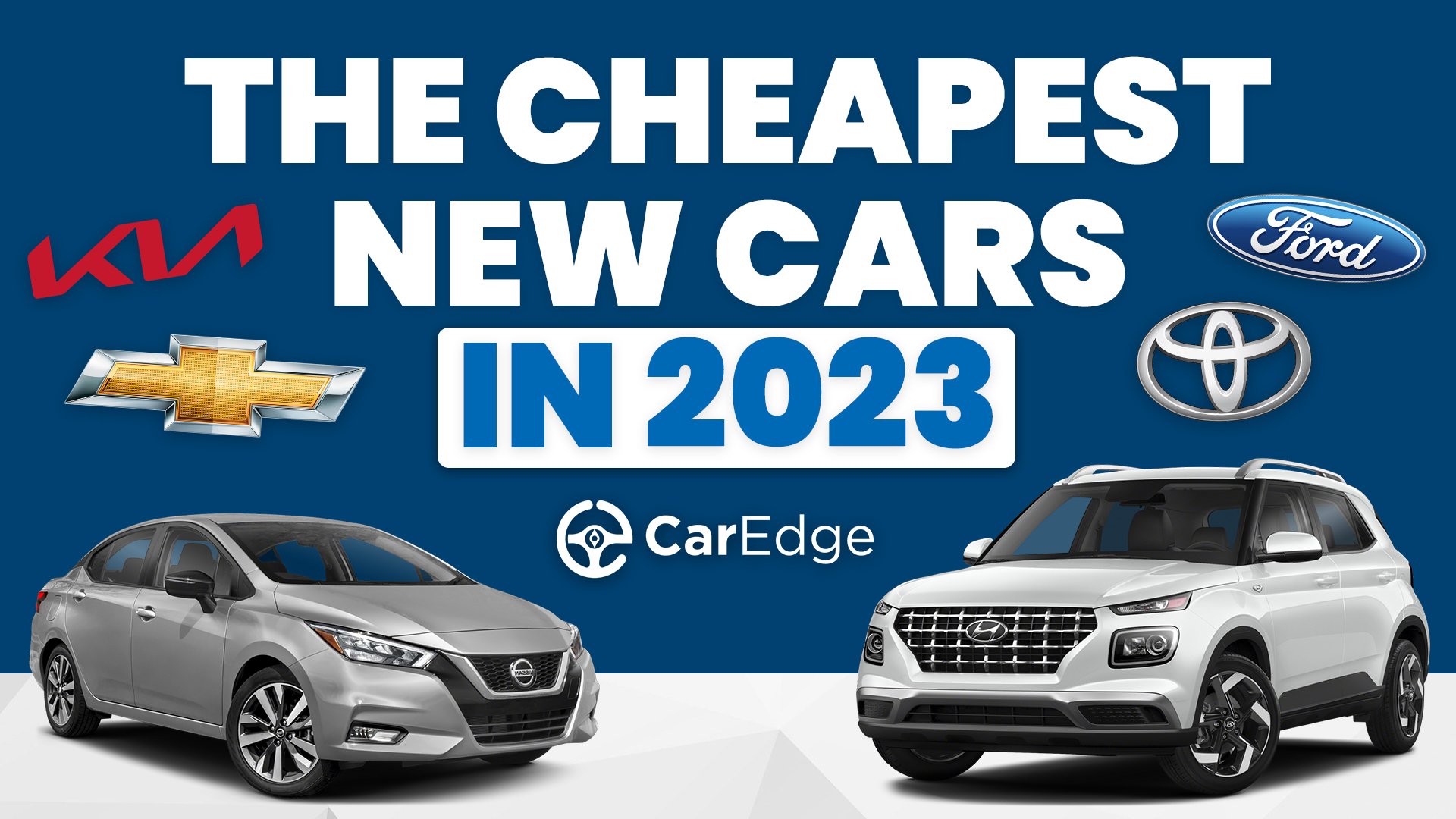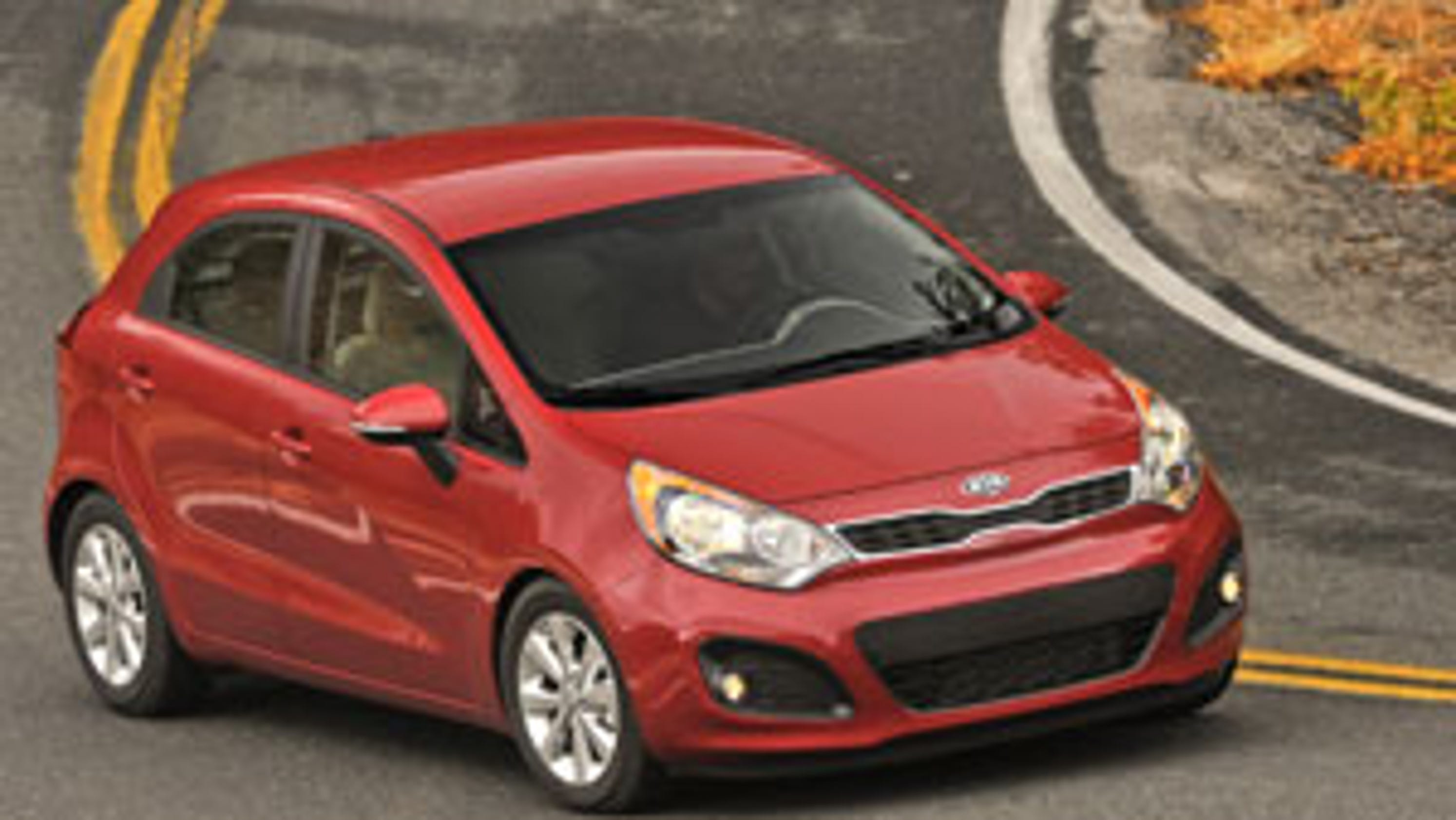What’s The Cheapest Car You Can Buy Brand New? cars.truckstrend.com
In an era defined by inflation, supply chain disruptions, and evolving consumer preferences, the quest for an affordable brand-new car has become increasingly challenging. Gone are the days when a reliable new vehicle could be had for under $15,000. Today, finding a car that truly fits the "cheapest" bill requires diligent research, a realistic understanding of what that price point entails, and an awareness of the total cost of ownership. This comprehensive guide will navigate the current landscape of budget-friendly new cars, helping you understand your options, what to expect, and important considerations beyond the sticker price.
The importance of finding an affordable new car cannot be overstated for many buyers. First-time car owners, students, those on a strict budget, or individuals simply seeking reliable basic transportation often prioritize cost above all else. A brand-new car, even a budget one, offers the peace of mind of a full warranty, the latest safety features (even if basic), and the knowledge that you’re the first owner, free from any hidden mechanical issues from previous use. However, the definition of "cheap" has shifted significantly, making this search more nuanced than ever before.
What’s The Cheapest Car You Can Buy Brand New?
The Evolving Landscape of "Cheap" New Cars
For decades, the subcompact segment was the undisputed king of affordability. Models like the Ford Fiesta, Chevrolet Spark, and Honda Fit offered basic, fuel-efficient transportation at rock-bottom prices. However, market trends have seen many manufacturers discontinue these smaller, less profitable vehicles in favor of more popular and higher-margin SUVs and crossovers. This shift, coupled with rising manufacturing costs, advanced safety mandates, and global economic pressures, has pushed the average transaction price of new vehicles steadily upwards.
Today, the term "cheapest new car" often refers to vehicles with a starting Manufacturer’s Suggested Retail Price (MSRP) hovering around the $16,000 to $20,000 mark. These vehicles are typically the absolute base trims, often lacking features considered standard just a few years ago, such as power windows, advanced infotainment systems, or even alloy wheels. The focus is purely on getting you from point A to point B safely and reliably, with minimal frills. Understanding this evolving landscape is the first step in setting realistic expectations for your budget car search.
Identifying the Contenders: Current Cheapest New Cars
While the list of truly inexpensive new cars has dwindled, a few steadfast models remain committed to affordability. These vehicles typically offer the lowest entry points into brand-new car ownership, prioritizing function over flash.
-
Mitsubishi Mirage (Hatchback/G4 Sedan): Consistently holding the title of the cheapest new car available in the U.S., the Mirage hatchback and its sedan sibling, the Mirage G4, are the epitome of no-frills transportation. Powered by a tiny 1.2-liter three-cylinder engine, it prioritizes fuel economy (often over 39 MPG combined) and a very low starting price. It’s compact, easy to park, and comes with a commendable 10-year/100,000-mile powertrain warranty. However, its acceleration is leisurely, and the interior is basic.

-
Nissan Versa (Sedan): The Versa offers a slightly more refined and spacious experience than the Mirage, often for a very similar price point. It features a 1.6-liter four-cylinder engine, providing a bit more pep, and boasts competitive fuel economy. Its interior, while still budget-oriented, feels more modern, and it offers a surprisingly large trunk. Standard features include automatic emergency braking, which is a significant plus at this price.

Kia Rio (Sedan/Hatchback): Kia’s entry-level offering, the Rio, stands out for its strong value proposition. It combines a peppy 1.6-liter engine with a surprisingly engaging driving experience for its class. The interior is well-designed and relatively comfortable, and like all Kias, it comes with an excellent 10-year/100,000-mile powertrain warranty. Both the sedan and hatchback variants offer practicality and decent fuel efficiency, making it a strong contender for those seeking a balance of price and quality.
-
Hyundai Venue (Subcompact SUV): While technically a subcompact SUV, the Venue is priced competitively with sedans and hatchbacks, making it one of the cheapest new SUVs available. It shares its powertrain with the Kia Rio (1.6-liter engine) and offers a slightly higher driving position and more rugged styling. Its compact dimensions make it ideal for city driving, and like Kia, Hyundai offers an impressive 10-year/100,000-mile powertrain warranty. Cargo space is limited compared to larger SUVs, but it offers more versatility than a traditional sedan.

These models represent the absolute floor in terms of new car pricing. Buyers should be aware that the advertised "starting MSRP" is for the absolute base model, often with a manual transmission (if available) and minimal features. Any upgrades, automatic transmissions, or optional packages will quickly increase the price.
Beyond the Sticker Price: True Cost of Ownership
While the initial purchase price is a critical factor, a truly "cheap" car must also be affordable to own in the long run. Savvy buyers consider the total cost of ownership, which includes several key elements:
- Fuel Economy: The smaller engines and lighter builds of these budget cars generally translate to excellent fuel efficiency. High MPG figures directly reduce your ongoing operating costs, which can save hundreds, if not thousands, of dollars over the vehicle’s lifespan.
- Insurance Costs: Generally, less expensive cars are cheaper to insure. Their lower replacement value and often less powerful engines can lead to lower premiums for collision and comprehensive coverage. However, factors like your driving record, location, and age will still play a significant role.
- Maintenance & Reliability: Parts availability and the cost of routine maintenance are important. The simpler engineering of many budget cars can mean lower labor costs for repairs. Models from brands like Kia and Hyundai often come with long warranties, providing peace of mind against major powertrain issues. Researching reliability ratings from consumer reports can offer insights into potential long-term issues.
- Depreciation: How well a car holds its value can impact its true cost. While all new cars depreciate, some budget models might depreciate faster than more popular segments. However, if you plan to keep the car for many years, depreciation becomes less of a concern. In a market where new cars are scarce, even entry-level models might hold their value better than in the past.
- Registration & Taxes: These vary by state and local municipality but are typically based on the vehicle’s purchase price or assessed value. A lower purchase price will result in lower initial registration fees and sales taxes.
Important Considerations When Buying a Budget New Car
Purchasing the cheapest new car on the market requires a different mindset than buying a mid-range or luxury vehicle. Here are crucial considerations:
- Features vs. Price: Understand that "cheapest" means basic. Expect manual seats, simple infotainment systems (often just a radio with Bluetooth), and perhaps steel wheels with hubcaps. Decide what features are absolute necessities for you (e.g., air conditioning, power windows, a rearview camera) and be prepared that even these might be optional on the very base trims.
- Safety Ratings: While all new cars sold in the U.S. must meet federal safety standards, budget cars may not have the same advanced safety features (like adaptive cruise control, lane-keeping assist) as more expensive models. However, basic features like multiple airbags, stability control, and sometimes automatic emergency braking are often standard. Check ratings from organizations like the IIHS (Insurance Institute for Highway Safety) and NHTSA (National Highway Traffic Traffic Safety Administration).
- Resale Value: If you plan to trade in or sell the car within a few years, research its potential resale value. While not a primary concern for long-term owners, it’s part of the overall financial picture.
- Warranty: The warranties offered by Kia and Hyundai (10-year/100,000-mile powertrain, 5-year/60,000-mile basic) are industry-leading and a significant advantage for budget-conscious buyers, providing extensive protection against unforeseen mechanical issues. Mitsubishi also offers a similar strong warranty.
- Financing Options: Even for a cheaper car, financing can add significantly to the total cost. Research interest rates from various lenders (banks, credit unions, dealership financing) and aim for the shortest loan term you can comfortably afford to minimize interest paid.
- Test Drive Thoroughly: Never buy a car without a comprehensive test drive. Pay attention to road noise, ride comfort, acceleration, braking, and overall driving dynamics. What feels "cheap" to one person might be perfectly acceptable to another. Ensure it meets your minimum expectations for daily usability.
Alternatives to Consider
If the cheapest brand-new cars don’t quite meet your needs or budget, or if you’re looking for more features for your money, several alternatives are worth exploring:
- Used Cars: The most obvious path to affordability. A slightly older used car can offer significantly more features, space, or performance for the same price as a new budget model. The trade-off is the lack of a new car warranty and the potential for unknown maintenance history.
- Certified Pre-Owned (CPO) Vehicles: These are used cars that have undergone a rigorous inspection and often come with an extended manufacturer’s warranty. CPO vehicles bridge the gap between new and used, offering some of the peace of mind of a new car at a lower price point.
- Leasing: While you don’t own the car, leasing can result in lower monthly payments compared to financing a purchase. It’s a good option for those who want a new car every few years and don’t mind mileage restrictions.
- Public Transportation/Ride-Sharing: For those with minimal driving needs, foregoing car ownership entirely and relying on public transport, ride-sharing services, or car-sharing programs can be the most cost-effective solution.
What’s The Cheapest Car You Can Buy Brand New: Price Table (Approximate Current MSRP)
| Model | Starting MSRP (Base Trim) | Engine (Base) | Transmission (Base) | EPA Fuel Economy (Combined MPG) | Key Standard Features (Brief) | Pros | Cons |
|---|---|---|---|---|---|---|---|
| Mitsubishi Mirage | ~$16,700 | 1.2L 3-Cylinder | 5-spd Manual / CVT | 39 (CVT) | 7-inch display audio, Bluetooth, Auto climate control, Rearview camera, Forward Collision Mitigation (FCM) | Lowest price, excellent fuel economy, great warranty, very maneuverable | Sluggish acceleration, basic interior, noisy cabin |
| Nissan Versa | ~$16,130 | 1.6L 4-Cylinder | 5-spd Manual / CVT | 35 (CVT) | 7-inch touchscreen, Apple CarPlay/Android Auto, Automatic Emergency Braking with Pedestrian Detection, Rear Automatic Braking, Lane Departure Warning (on SV/SR) | Comfortable ride, spacious interior for its class, good standard safety | Less engaging to drive than competitors, base models lack power windows |
| Kia Rio | ~$17,000 | 1.6L 4-Cylinder | CVT | 36 | 8-inch touchscreen, Wireless Apple CarPlay/Android Auto, Rearview camera, Forward Collision-Avoidance Assist w/ Pedestrian Detection (on S trim) | Strong warranty, good handling, modern interior, standard wireless CarPlay | Slightly higher starting price, base model is very basic |
| Hyundai Venue | ~$19,900 | 1.6L 4-Cylinder | CVT | 31 | 8-inch touchscreen, Wireless Apple CarPlay/Android Auto, Automatic Temperature Control, Forward Collision-Avoidance Assist, Lane Keeping Assist, Driver Attention Warning | Compact SUV styling, strong warranty, good for city driving, standard wireless CarPlay | Limited cargo space, less powerful engine for an SUV, AWD not available |
Note: Prices are approximate MSRP for the base trim and do not include destination charges, taxes, or optional features. Prices are subject to change by the manufacturer.
Frequently Asked Questions (FAQ)
Q1: Why are new cars so expensive now?
A1: Several factors contribute to higher new car prices: increased manufacturing costs, global supply chain disruptions (especially for semiconductors), higher demand for SUVs/trucks (which are more expensive), and the inclusion of more standard safety and technology features required by regulations or consumer demand.
Q2: Are cheap new cars safe?
A2: Yes, all new cars sold in the U.S. must meet stringent federal safety standards. While they may lack advanced driver-assistance systems found in more expensive vehicles, they are designed with multiple airbags, stability control, and often include basic automatic emergency braking. Always check independent safety ratings from organizations like IIHS and NHTSA.
Q3: Do cheap new cars have good features?
A3: The cheapest new cars typically have basic features to keep the price low. Expect manual windows, simple infotainment systems (often just a radio with Bluetooth), and basic cloth upholstery in the absolute base trims. However, many now offer essential modern features like rearview cameras and basic smartphone integration (Apple CarPlay/Android Auto) even at entry levels.
Q4: What’s the best way to finance a cheap new car?
A4: Shop around for the best interest rates from various lenders, including banks, credit unions, and the dealership’s financing department. Credit unions often offer competitive rates. Aim for the shortest loan term you can comfortably afford to minimize the total interest paid over the life of the loan. A larger down payment also helps reduce monthly payments and overall interest.
Q5: Is it better to buy a cheap new car or a used car?
A5: This depends on your priorities. A cheap new car offers a full warranty, no prior owner history, and the latest safety tech. A used car, especially one a few years old, can offer more features or a larger vehicle for the same price, but comes with the risk of unknown maintenance history and typically a shorter or no warranty. If peace of mind and a warranty are paramount, a new car is better. If maximizing features per dollar is the goal, a used car might be preferable.
Conclusion
Finding the cheapest car you can buy brand new in today’s market is a journey that demands clarity, research, and realistic expectations. While the days of sub-$15,000 new cars are largely behind us, models like the Mitsubishi Mirage, Nissan Versa, Kia Rio, and Hyundai Venue continue to offer accessible entry points into new vehicle ownership. These vehicles prioritize affordability, fuel efficiency, and basic functionality, making them ideal for budget-conscious buyers seeking reliable transportation with the security of a factory warranty.
Remember that the "cheapest" car isn’t just about the sticker price; it encompasses the total cost of ownership, including fuel, insurance, and maintenance. By carefully considering your needs, exploring all available options, and understanding the true value proposition, you can confidently navigate the market and drive away in a brand-new car that fits both your lifestyle and your budget. While "cheap" may mean fewer frills, it doesn’t have to mean sacrificing reliability or peace of mind.

